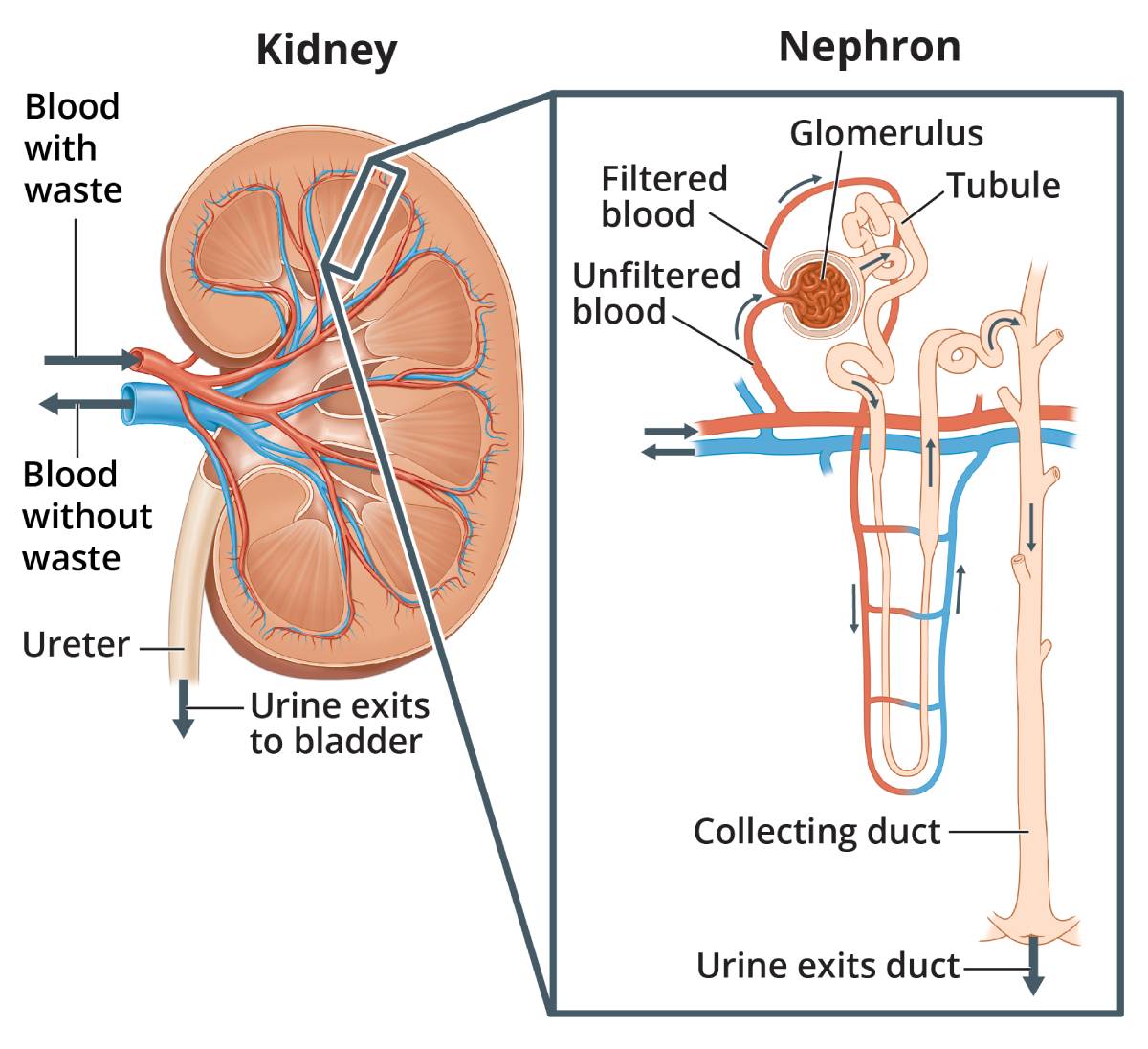Glomerular filtration rate (GFR) – meaning and limitations
This is an article for those of you who want to know more about GFR – what it is, and its pros and cons. It is a very controversial area.
Definition of GFR
Glomerular filtration is the first stage of the formation of urine. It is therefore an essential function of the kidney.
Glomerular filtration rate (GFR) = the volume of fluid filtered by the renal (kidney) glomerular capillaries into the Bowman’s capsule per unit time. It is expressed in milliliters per minute (mls/min).

What does GFR mean?
Glomerular filtration rate (GFR) is generally accepted as the best overall measure of functioning kidney tissue in both health and disease; the higher the GFR, the more the functioning kidney tissue, the better.
Thus the GFR rate is used as a measure of kidney function; as it describes the flow rate (in mls/min) of filtered fluid through the kidney.
In other words, GFR is a ‘surrogate’ (represents) kidney function. But it is not a single number that tells you exactly what is the kidney function.
Why? First of all, there is no such thing as ‘kidney function’. There is no such thing as ‘brain or skin function’, so why should the kidneys be any different?
And secondly, even if there was, it is unlikely that we will come up with a single number to quantify it.
Note. GFR measures only one (of seven) functions of the kidney, i.e. glomerular filtration (see below).
Normal GFR
Average human GFR, adjusted for body surface area, is approximately 120 ml/min/1.73 m2. No one knows the exact number. But this is an average, from a range of 100-130 mls/min – not all humans are the same. Hence there will be normal humans with a normal GFR of 90 or 140 mls/min. Read here for a more accurate human GFR (117 ml/min!).
The GFR is adjusted for body surface area since bigger kidneys can filter more fluid, and kidneys get bigger as body surface area gets bigger.
How is GFR (and eGFR) measured?
It is difficult to measure GFR directly. So it is normally estimated. This means it is calculated from other numbers.
So the GFR that comes back with kidney blood tests is an estimated GFR (eGFR) – and is mathematically derived (invented!) from the blood creatinine level, combined with the patient’s age, size and gender. Creatinine is a waste substance that is removed less well by kidneys in CKD – hence the lower the number the better (the opposite of GFR). Normal creatinine is 60-120 mcmol/L. Like GFR, it is a key measure of kidney function.
Hence GFR is calculated by the laboratory analysing the blood sample (with creatinine) and reporting it along with the blood creatinine result.
An example could be a patient with a blood creatinine of 87 mcmol/L, and GFR 112 mls/min – i.e. both are normal, and kidney function is ‘normal’. But that does not mean they do not have kidney disease, just that one aspect of kidney function is normal; or least ‘normal’ in the way we describe normality.
What affects GFR apart from glomerular filtration?
The GFR varies according to:
- Age – decreases with age. Many doctors believe GFR naturally falls by 1 ml/min per year from the age of 40 – and that is a normal part of ageing and not a disease. Hence someone who has a GFR of 100 ml/min at 40 years, may have a GFR of 59 ml/min at 81 years, and according to the CKD/GFR 5 stage classification, has Stage 3 CKD. They do not. They are normal
- Gender – higher in men
- Body size – higher in larger people.
CKDEx has more information here on the effects of age and gender.
Care with interpretation
Due to the above (and below) care must be taken with the interpretation of GFR.

Limitations of GFR measurement
“GFR is only an estimate of kidney function and a significant error is possible.”
- The eGFR is inaccurate:
– in people at extremes of body type – e.g. patients with limb amputations, severely malnourished and morbidly obese people
– at very low GFR levels – e.g. below 15 ml/min - Values differ between laboratories
- Creatinine level must be stable. eGFR calculations assume that the level of creatinine in the blood is stable over days or longer, i.e. in steady-state. It is therefore not valid in patients with acute kidney injury (AKI) or in patients receiving dialysis, for example.
Other functions of the kidney – and why GFR is not % kidney function
As stated above, glomerular filtration is only one (of seven) functions of the kidney. Therefore, it is wrong, as many doctors and nurses do, to express GFR as a % kidney function. The other six functions are described on CKDEx here.
Also. As average human GFR is 120 ml/min, and is not 100, GFR should not be expressed as a percentage for that (mathematical) reason.
Summary
We have described the glomerular filtration rate (GFR) – and its meaning and limitations. We hope it has been helpful.
Other resources
The UKKA has more information on GFR and its meaning here.
What is normal GFR?
CKD: disease or normal ageing?
Finally .. a (nice) coincidence
Oh yes. Have you spotted the nice coincidence? Normal human GFR is 120 ml/min and the upper limit of normal creatinine in the blood is .. yes .. 120 mcmol/L.
[“Does this mean that kidney doctors are not as clever as they think they are, as they only have to remember one number?” Yes! CKDEx Ed]
Last Reviewed on 11 May 2024


